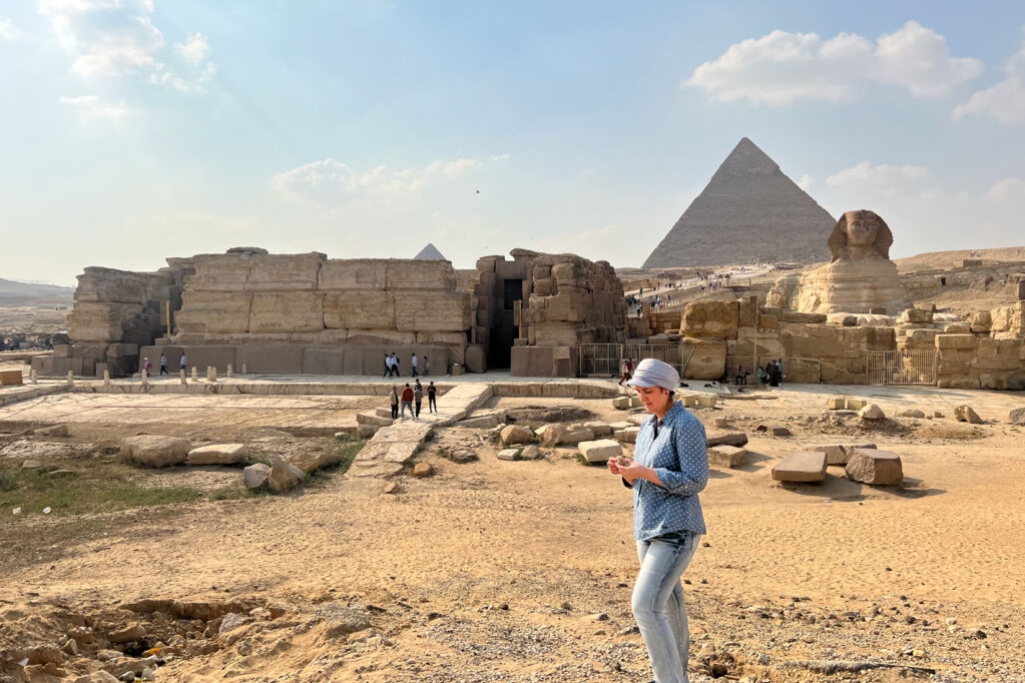
Eman Ghoneim at the site of the lost branch of the Nile she and researchers discovered near a group of pyramids between Giza and Lisht.
GIZA, Egypt (BP) — The discovery of a former branch of the Nile offers clues to the construction of the pyramids and Egyptian culture when the Israelites were in bondage, Southern Baptist Archeologist Jim Parker told Baptist Press.
Using satellite imagery, geophysical surveys and sediment samples in the Nile Valley, researchers led by University of North Carolina Wilmington Professor Eman Ghoneim made the discovery announced May 16 in the Communications Earth and Environment journal. While experts have suspected for some time that the Nile had shifted, the new research is the first confirmation of the former riverbed.
The abandoned branch, about three miles west of the current Nile’s location, would have flowed between 2686 BC and 1649 BC, researchers said, overlapping with when the pyramids were erected between 3000 and 2300 BC, as well as during the Israelites’ enslavement that began in the late 1800s BC and continued about 400 years.
Parker, the McFarland chair of Old Testament and archaeology at New Orleans Baptist Theological Seminary and executive director of the school’s Michael and Sara Moskau Institute of Archaeology, said he has followed the research with excitement.
“If the river had been near the pyramids, that’s where the villages would have been, would have been near the river,” Parker said. “The idea is we may discover more of the ancient villages there that could help us understand the life in that period of time.
“This could give us an understanding of the culture,” he said. “Particularly this later date, 1600, is very close to what we believe is the time the Israelites were enslaved there in Egypt.
“Anything that we can learn that touches nearby the biblical story, Old or New Testament, is always important to us.”
It’s not that the findings prove what we already know from Scripture, Parker said, but the findings can expand interpretation to understand more fully God’s Word.
The findings could give clues to other questions from the era, Parker said, such as the river’s navigation and the construction of boats or barges sufficient to carry the large stones from quarries and down the river to the pyramid sites. Many of the pyramids are at the end of what would have been causeways leading to the river, researchers said.
Parker surmised the research could open the door to other findings, perhaps including other pyramids built in the area that would be buried beneath 50 or so feet of sand.
Rivers are known to shift based on such factors as the movement of the earth’s tectonic plates, precipitation and sedimentation.
The Nile has long been considered fundamental to the growth and expansion of the Egyptian civilization.
Still a question is why the pyramids were built, but Parker said new research continues to strengthen the premise that the pyramids were used as celestial observation sites.
“We’re still curious, nobody knows exactly why they built the pyramids,” Parker said. “But it seems that — more and more — it seems that these were brought to points and they were set in certain locations based on (the society’s) observation of the heavenlies and what’s going on.”
Researchers named the lost branch of the Nile the Ahramat Branch, based on the Arabic word for pyramid, and said it would have been a functional waterway of great significance.
“The finding of the Ahramat Branch is not only crucial to our understanding of why the pyramids were built in these specific geographical areas, but also for understanding how the pyramids were accessed and constructed by the ancient population,” researchers wrote in Communications Earth and Environment. “It has been speculated by many scholars that the ancient Egyptians used the Nile River for help transporting construction materials to pyramid building sites, but until now, this ancient Nile branch was not fully uncovered or mapped.
“This work can help us better understand the former hydrological setting of this region,” researchers wrote, “which would in turn help us learn more about the environmental parameters that may have influenced the decision to build these pyramids in their current locations during the time of Pharaonic Egypt.”
The research paper is fully accessible online at nature.com.
(EDITOR’S NOTE — Diana Chandler is Baptist Press’ senior writer.)


